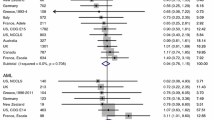Abstract
Objective: Studies have suggested an association between maternal hair dye use and elevated risk of childhood cancer, including neuroblastoma. We analyzed data from a large case–control study to investigate the relationship between maternal hair dye use around pregnancy and risk of neuroblastoma in offspring.
Methods: Cases were children with neuroblastoma diagnosed between 1992 and 1994 at hospitals in the United States and Canada participating in the Children’s Cancer Group or the Pediatric Oncology Group. Random-digit dialing was used to identify one matched control for each case. Information on hair dye use was gathered from telephone interviews of 538 case and 504 control mothers.
Results: Use of any hair dye in the month before and/or during pregnancy was associated with a moderately increased risk of neuroblastoma (adjusted odds ratio (OR) = 1.6; 95% confidence interval (CI) = 1.2–2.2). Temporary hair dye use (OR = 2.0, CI = 1.1–3.7) was more strongly associated with neuroblastoma than use of permanent hair dye (OR = 1.4, CI = 1.0–2.0).
Conclusion: Although the results of this study provide evidence of an association between maternal hair dye use and neuroblastoma, further research is necessary to evaluate effects by method of hair dye application, color, and chemical composition.
Similar content being viewed by others
References
J Little (1999) Epidemiology of Childhood Cancer International Agency for Research on Cancer Lyon 1, 51–52
MT Goodman JG Gurney MA Smith AF Olshan (1999) Sympathetic nervous system tumors LAG Ries MA Smith JG Gurney M Linet T Tamra JL Young GR Bunin (Eds) Cancer Incidence and Survival among Children and Adolescents: United States SEER Program 1975–1995 National Cancer Institute Bethesda, MD 65–72
AF Olshan GR Bunin (2000) Epidemiology of Neuroblastoma GM Brodeur T Sawada Y Tsuchida PA Voute (Eds) Neuroblastoma Elsevier Amsterdam 33–39
EA Holly PM Bracci MK Hong BA Mueller S Preston-Martin (2002) ArticleTitleWest Coast study of childhood brain tumours and maternal use of hair-colouring products Paediatr Perinat Epidemiol 16 226–235 Occurrence Handle10.1046/j.1365-3016.2002.00420.x Occurrence Handle12123435
S Kramer E Ward AT Meadows KE Malone (1987) ArticleTitleMedical and drug risk factors associated with neuroblastoma: a case–control study J Natl Cancer Inst 78 797–804 Occurrence Handle3471992
GR Bunin JD Buckley CP Boesel LB Rorke AT Meadows (1994) ArticleTitleRisk factors for astrocytic glioma and primitive neuroectodermal tumor of the brain in young children: a report from the Children’s Cancer Group Cancer Epidemiol Biomarkers Prev 3 197–204 Occurrence Handle8019366
GR Bunin S Kramer O Marrero AT Meadows (1987) ArticleTitleGestational risk factors for Wilms’ tumor: results of a case–control study Cancer Res 47 2972–2977 Occurrence Handle3032418
International Agency for Research on Cancer (1993) Occupational Exposures of Hairdressers and Barbers and Personal Use of Hair Colourants; Some Hair Dyes, Cosmetic Colourants, Industrial Dyestuffs and Aromatic Amines. Lyon, France: International Agency for Research on Cancer, pp. 43–53, 63–64, 93–94, 129–212.
GJ Nohynek R Fautz F Benech-Kieffer H Toutain (2004) ArticleTitleToxicity and human health risk of hair dyes Food Chem Toxicol 42 517–543 Occurrence Handle10.1016/j.fct.2003.11.003 Occurrence Handle15019177
L Tomatis (1989) Overview of perinatal and multigeneration carcinogenesis NP Napalkov JM Rice L Tomatis H Yamasaki (Eds) Perinatal and Multigeneration Carcinogenesis NumberInSeries96 International Agency for Research on Cancer Lyon, France 1–15
AF Olshan AJ DeRoos K Teschke et al. (1999) ArticleTitleNeuroblastoma and parental occupation Cancer Causes Control 10 539–549 Occurrence Handle10.1023/A:1008998925889 Occurrence Handle10616823
AF Olshan J Smith MN Cook et al. (1999) ArticleTitleHormone and fertility drug use and the risk of neuroblastoma: a report from the Children’s Cancer Group and the Pediatric Oncology Group Am J Epidemiol 150 930–938 Occurrence Handle10547138
FA Carey (1996) Organic Chemistry EditionNumber3 University of Virginia McGraw-Hill 927–928
W Lijinsky (1999) ArticleTitleN-Nitroso compounds in the diet Mutat Res 443 129–138 Occurrence Handle10415436
GM Brodeur JM Maris DJ Yamashiro MD Hogarty PS White (1997) ArticleTitleBiology and genetics of human neuroblastomas J Pediatr Hematol Oncol 19 93–101 Occurrence Handle10.1097/00043426-199703000-00001 Occurrence Handle9149737
M Schwab (2004) ArticleTitleMYCN in neuronal tumours Cancer Lett 204 179–187 Occurrence Handle10.1016/S0304-3835(03)00454-3 Occurrence Handle15013217
DN Shapiro MB Valentine ST Rowe et al. (1993) ArticleTitleDetection of N-myc gene amplification by fluorescence in situ hybridization: diagnostic utility for neuroblastoma Am J Pathol 142 1339–1346 Occurrence Handle7684192
GM Brodeur RP Castleberry (1993) Neuroblastoma PA Pizzo DG Poplack (Eds) Principles and Practice of Pediatric Oncology JB Lippincott Company Philadelphia, PA 739–768
KJ Rothman S Greeland (1998) Modern Epidemiology EditionNumber2 Lippincott Williams & Wilkins Philadelphia, PA 126–127
C Infante-Rivard L Jacques (2000) ArticleTitleEmpirical study of parental recall bias Am J Epidemiol 152 480–486 Occurrence Handle10981463
J Schuz LG Spector JA Ross (2003) ArticleTitleBias in studies of parental self-reported occupational exposure and childhood cancer Am J Epidemiol 158 710–716 Occurrence Handle10.1093/aje/kwg192 Occurrence Handle14507608
CD Drews JF Kraus S Greenland (1990) ArticleTitleRecall bias in a case–control study of sudden infant death syndrome Int J Epidemiol 19 405–411 Occurrence Handle2376455
Author information
Authors and Affiliations
Corresponding author
Additional information
* Work on this study was performed at the Department of Epidemiology, School of Public Health, University of North Carolina, Chapel Hill, NC, USA
Rights and permissions
About this article
Cite this article
McCall, E.E., Olshan, A.F. & Daniels, J.L. Maternal hair dye use and risk of neuroblastoma in offspring*. Cancer Causes Control 16, 743–748 (2005). https://doi.org/10.1007/s10552-005-1229-y
Received:
Accepted:
Issue Date:
DOI: https://doi.org/10.1007/s10552-005-1229-y



